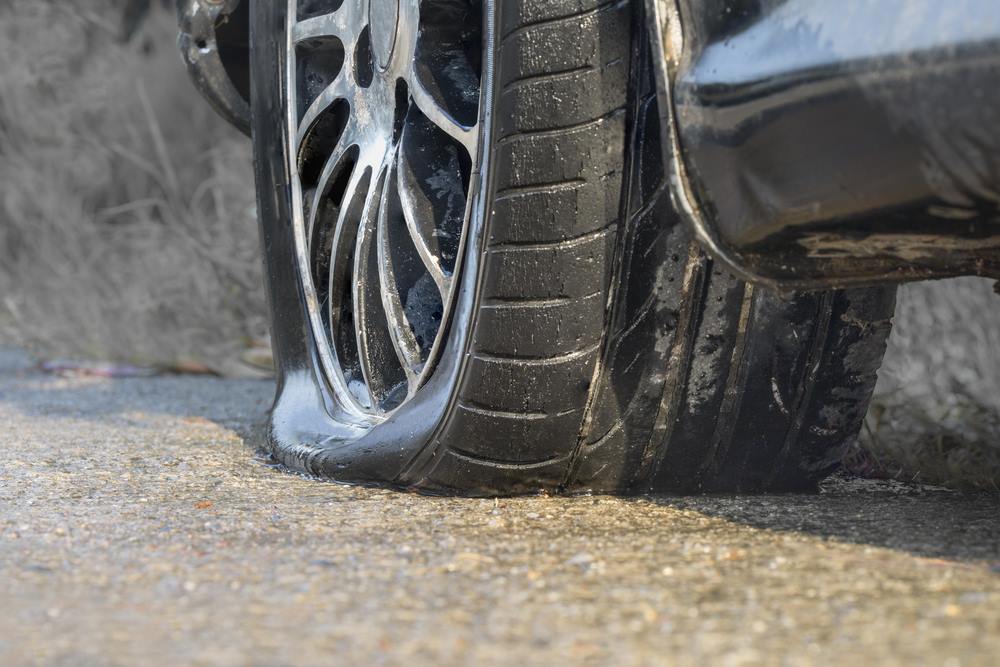Tire blowouts are a common cause of car accidents and can be extremely dangerous. Tire blowout accidents can happen for many reasons, but whatever the cause, the result can be devastating. Tire blowouts turn drivers into passengers, sending them skidding along the road — and potentially into the path of other vehicles.
In this blog, we tell you everything you need to know about tire blowout accidents, including their causes, signs to look out for, who is liable, and what to do if you’re in an accident.
What Causes Tire Blowout Accidents?
All causes of car accidents typically fall into one of three categories:
- Driver-led
- Manufacturer-led
- Environment-led.
Tire blowout accidents are no exception, although they can happen due to a combination of factors.
Some of the most common causes of tire blowouts are:
Areas in Greater San Antonio We Serve
Old Tires
Tires don’t last forever, and as they age, the tread can become brittle and crack, increasing the likelihood of a tire blowout. Drivers need to carefully monitor the condition of their tires to ensure they don’t set out on the road with compromised tires.
Overloading a Vehicle
Cars can only withstand so much weight. Carload limits naturally vary based on the model — a station wagon will withstand more weight than a small coupe. Carrying too much weight will put extra strain on the tires, potentially leading to a blowout. This isn’t the only concern, though. Overloading a vehicle can also stress the brakes and suspension, increasing the risk of failure.
Poor Tire Pressure
Tire pressure is a tricky balance. If a tire is overinflated, it can become stiff and more susceptible to damage from potholes and curbs. It can also change the tire’s shape, increasing wear and tear in certain areas. However, underinflating a tire can be equally dangerous. When a tire is underinflated, more of the tire will touch the road, leading to increased friction, overheating, and wear. Again, motorists must ensure they routinely check tire pressure before driving.
Manufacturing Defects
You can do everything right — change your tires regularly, check their pressure, and avoid overloading your vehicle — and still end up in a tire blowout accident. Unfortunately, there can be fundamental flaws in the design or manufacture of your tires, and you likely won’t know about it until it’s too late.
Poor Road Conditions
Road defects like potholes, debris, and hazards all pose a threat to tires. These environmental factors are usually unavoidable — you can’t swerve on the road to avoid a pothole — but they can also be aggravated by other causes of tire blowout accidents. For example, if a tire is aged and worn and a driver has failed to change it, thinking they can eke out a couple more journeys and driving in poor road conditions can be all it takes to tip a tire over the edge and cause a tire blowout accident.
Extreme Weather Conditions
Nobody can control the weather — much as we’d like to — so it’s vital to take proper care when driving in inclement conditions such as rain, ice, and snow. Even a particularly cold day can decrease tire pressure and increase the risk of a blowout. However, hot weather poses a risk too. Warm temperatures can increase tire pressure, leading to issues associated with overinflating a tire.
If you’re in an accident where the other driver’s tires blow because of weather conditions, it’s easy to assume nobody is at fault — you can’t sue the weather! However, if it’s revealed that the tires were at the end of their life and needed replacing, you may be able to hold the driver accountable.
Determining the cause of a tire blowout accident is the first step to finding out who might be responsible.
What Are the Signs of a Tire Blowout?
Tire blowout accidents can happen at a moment’s notice, especially if you suddenly drop off a curb or hit a deep pothole, but some signs can indicate a blowout might be imminent or has happened. These include:
Sudden loss of air pressure: Tire damage and temperature changes can cause a rapid loss of air pressure. If your tire pressure light flashes or you notice a change in how your car handles, it could be a sign of an impending tire blowout.
Loud noise or explosion: In a tire blowout accident, you may hear a loud, explosion-like noise as your tires blow.
Losing control of a vehicle: Losing control can happen for several reasons, including reckless driving (such as speeding or braking suddenly), but it can also happen after a tire blowout.
How to Prevent Tire Blowout Accidents
While tire blowout accidents can be unavoidable — such as if there’s a manufacturing defect — you can take steps to reduce the risk of a tire blowout accident.
These include:
- Routinely getting your tires inspected by a professional mechanic.
- Checking your tire pressure and making sure your tires are not over or underinflated.
- Making sure you adhere to your vehicle’s recommended loading limits to prevent tire damage from overloading.
- Avoiding road hazards, where possible.
- Replacing your tires regularly, even if they appear in good condition. You should replace your tires every six years or after 36 thousand to 75 thousand miles. This is a broad range, so make sure you also monitor tire pressures and overall health.
Who’s Liable for a Tire Blowout Accident?
If you’re in a tire blowout accident, you might sustain severe injuries and need time off work. You may be entitled to file a personal injury claim to recover your medical bills, lost wages, and additional damages for pain and suffering.
But to successfully recover compensation, you must identify the party at fault and gather evidence to prove they were responsible for the accident.
Several parties can be liable for a tire blowout accident, including:
- You
- The other driver
- The tire manufacturer
- A government agency or contractor
- A mechanic.
Who is liable ultimately depends on the facts of your accident. Let’s look at some scenarios to illustrate who can be at fault.
Scenario 1
What happened: You’re driving down the road, and your tires blow, causing you to swerve and crash into an oncoming vehicle. Both you and the other driver sustain head injuries. An investigation reveals that your tires were worn and needed replacing.
Who might be responsible: In this case, you will likely be held liable for the accident, as it was your responsibility to check your tires before driving. The other driver might also try to recover compensation from you. However, there are exceptions. If the other driver was speeding or driving while distracted, they may be partially at fault. Whether or not you can claim compensation depends on if you are deemed to be less than 51% responsible. If you are, you can recover compensation equal to your level of fault.
Scenario 2
What happened: You’re driving carefully down the highway, and your tire blows. An investigation discovered there was a manufacturing defect in the blown tire.
Who might be responsible: In this scenario, the tire manufacturer can be held liable for your injuries.
Scenario 3
What happened: You sustain an injury in an accident with a speeding driver after their tires blow. You consult your local McAllen personal accident lawyer, who investigates the accident and discovers the other driver recently had their car serviced, and the mechanic failed to spot heavily worn tires.
Who might be responsible: You may be able to recover compensation from both the mechanic, who failed to spot the tire problem, and the driver, who was speeding and failed to check their tires themselves.
Scenario 4
What happened: As you’re driving, you see the vehicle two cars ahead of you has a tire blowout. The driver avoids contact with other vehicles and crashes into a guardrail. However, this causes the driver ahead of you to brake suddenly, giving you no time to react. You rear-end the car ahead and sustain a whiplash injury.
Who might be responsible: In this case, the driver whose tires had blown can be held responsible for your injuries, even though they did not directly hit you. This will depend on what ultimately caused the tires to blow (such as a manufacturing defect or driver error).
As you can see, liability depends on several factors, including the events leading up to the accident and whether you or another driver suffered a blowout.
What to Do If You’re in a Tire Blowout Accident
A tire blowout accident — like any other type of car accident — can be terrifying. While it can be difficult to stay calm, there are several steps you should ideally take after an accident.
If You Experience a Tire Blowout
If your tires blow, you should avoid slamming the brakes, which can cause you to lose control even more. Instead, gently ease off the gas and try to keep your vehicle straight. As you slow down and regain control of your car, get the vehicle off the road.
In any tire blowout accident, you should also do the following:
Call the police: In Texas, you must report any car accident that causes property damage, injury, or death. When the police arrive, they will question you, others involved, and witnesses to understand what happened. This information will go into a document called a crash report, which can be a vital piece of evidence in a personal injury claim.
Seek medical attention for your injuries, even if you feel fine: Adrenaline can kick in after an accident and mask the pain of potentially severe injuries. Other injuries, such as concussion and whiplash, don’t show signs immediately. Seeing a doctor provides a medical record of when your injuries occurred, which can support a compensation claim.
Document the scene: If possible, take photos or videos of the scene, including the weather conditions, the other vehicles involved, your injuries, and any damage to your car. You should also collect the contact information of any witnesses to your tire blowout accident.
Notify your insurance company: You should then report the accident to your insurance company. Even if you’re entitled to recover compensation from another person or party’s insurance, your own insurance can help you cover immediate medical treatment or repairs.
Get in touch with a personal injury lawyer: A car accident attorney can let you know if you have a claim and how much you might be entitled to and gather evidence to prove who was at fault. They can also postpone your medical bills so you can focus on your recovery, negotiate a settlement with insurance companies on your behalf, and, if necessary, represent you in court.
If you’ve been involved in a tire blowout accident, you may be able to file a personal injury claim. Tire blowout accidents can be complicated, but our dedicated car accident lawyers in McAllen and San Antonio can protect your rights and fight for the compensation you deserve. To find out if you have a claim, call 855-LAW-NINJA or fill in the contact form.

